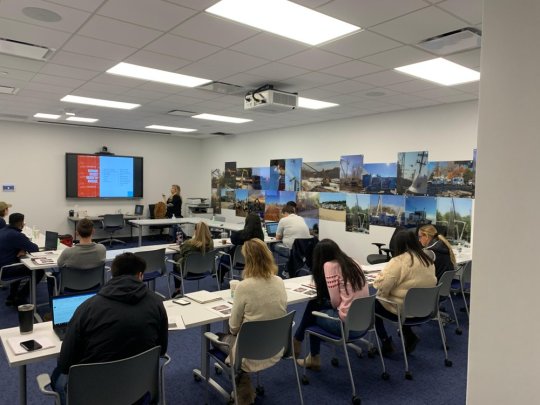#scaffolding platform
Explore tagged Tumblr posts
Video
youtube
320mm Steel Decks Manufacturing - Wellmade China - European Standard Rin...
#youtube#steel decks#scaffolding decks#scaffold decks#steel platform#scaffolding platform#layher decks#layher scaffolding#layher scaffold#allroundscaffolding#ringlock scaffolding#ringlock#ring system scaffold#wellmade scaffold#wellmade
0 notes
Text
name one good thing that happens in a cathedral
#now you may interpret this post in a number of ways but this is actually about how#mse's playing lies of p#i s2g i now spent more time on those scaffoldings than any boss fight#and i probably had like 25 go at the furnace monster#why would you do this to me game i'm already bad at soulslikes#must you bring in my archnemesis (3d platforming) into this?
21 notes
·
View notes
Text
Chemey is preferred Global Supplier of safety railing systems, Hard yet portable Barricades, fall protection solutions and safe access equipment for working at height.
#Chemey#Chemey Mechatronics#Chemey Mechatronics LLP#Industrial Solutions#Industrial Safety#Safety Solutions#Safety Products#Safety Equipments#Industrial Safety Solutions#Industrial Safety Products#Slip-On Fittings#Modular Guard Rail Solution#Tanker Access Platform#Aluminium Slip-On Fittings#Self-Closing Industrial Safety Gates#Osha Safety Gates#Rooftop Guardrails#Skylight Safety Cover#Tanker Truck Access Platform#Aluminium Industrial Floor Grating#Portable Work Platforms#Modular Safety Railing#Mezzanine Safety Barriers#Mobile Tanker Ladder#Self-Closing Safety Gates#Aluminum Structural Fittings#Mezzanine Pallet Gate#Modular Safety Rail Systems#Rooftop Walkway#Scaffold Mobile Tower
2 notes
·
View notes
Text





Check out this guy using a multi-neck guitar for a song with 3 chords lol




Third Eye Blind - Never Let You Go (2000)
#music video#y2k#00s pop#2000s#00s#2000#third eye blind#never let you go#multineck guitar#clouds#scaffolding#sky#stage#platform#multi-neck guitar#guitar#band
14 notes
·
View notes
Text

#Aluminum Scaffolding#Aluminum Scaffold Towers#Aluminum Scaffolding System#Aluminum Scaffolding Rental#Buy Aluminum Scaffold#Aluminum Scaffolding for Sale#Aluminum Scaffolding Suppliers#Aluminum Scaffold Platforms#Aluminum Scaffolding Rental Services#Aluminum Scaffolding Manufacturers#Lightweight Aluminum Scaffolding
2 notes
·
View notes
Text
Best Practices and Safety Protocols to Prevent Accidents and Injuries
For several businesses, such as building, maintenance, and warehousing, aerial work platforms, or aerial work platforms, are indispensable equipment. However, there are risks associated with using this equipment. Following safety procedures and guidelines is essential to avoiding mishaps and injuries. The following best practices will help to guarantee that aerial work platforms are operated safely
Pre-Operational Inspections Before using an aerial work platform, a thorough pre-operational inspection must be completed. This examination should include examining the tires, hydraulic systems, safety devices, and structural integrity. Any defects or flaws should be fixed in some way to prevent accidents.
Safe Work Environment
The establishment of a safe working environment is necessary for the safe operation of aerial work platforms. This entails ensuring that the ground is stable, level, and clear of obstacles and dangers. Additionally, operators need to be aware of overhead risks such as power wires and other potentially hazardous machinery.
Use of Personal Protective Equipment (PPE)
Operators and workers should always wear the appropriate personal protective equipment (PPE) when using an aerial work platform. This includes harnesses, helmets, safety glasses, and gloves. PPE provides an additional layer of protection in the case of an accident.
Load Capacity and Stability
Following the manufacturer's recommended load capacity is essential to preserving the aerial work platform's stability. Tipping and other mishaps may result from overloading the platform. In order to avoid imbalance, operators should also make sure that the load is spread uniformly.
Regular Maintenance
Regular maintenance is necessary to keep aerial work platforms in optimal operational conditions. This includes changing out worn-out parts, lubricating moving parts, and performing routine inspections. Planned maintenance helps identify potential issues before they become significant ones.
Following Manufacturer Guidelines
The manufacturer's instructions and recommendations must be followed in order for aerial work platforms to be operated safely. These guidelines provide important information about proper use, maintenance, and safety protocols. These rules should always be followed by operators to prevent accidents and injury.
Avoiding Unsafe Practices
Using the aerial work platform for purposes other than those for which it was intended, stepping on guardrails, and disregarding safety precautions are all dangerous actions that operators should avoid. Since unsafe activities increase the risk of accidents, they ought to be prohibited.
Monitoring and Supervision
Constant monitoring and supervision are required to ensure that safety protocols are being followed. Supervisors should regularly check that operators are adhering to safety procedures and take corrective action if necessary. Regular audits and inspections can help to maintain a safe workplace.
Staying Updated on Safety Regulations
Standards and laws pertaining to the safety of aerial work platforms are constantly evolving. Operators and supervisors should stay up to date on new regulations and industry best practices. Participating in safety workshops, seminars, and training programs can help staff members stay informed and compliant.
Selecting the right aerial work platform (AWP) for your project is crucial to ensuring efficiency, safety, and production. With the wide range of aerial work platforms available, it's important to understand your project's specific requirements and how different AWPs might meet them. When choosing the ideal aerial work platform for your tasks, keep these points in mind.
Knowing the particular needs of your project is the first step in choosing the best aerial work platform. Think about things like the kind of labor being done, the weight capacity needed, and the height you must reach. For instance, a maintenance operation can call for a different AWP than a construction project. You can reduce your selections by being aware of the specific requirements of your project.
Types of Aerial Work Platforms
There are several types of aerial work platform rental, each designed for different tasks and environments. Some common types include:
Scissor Lifts: Ideal for tasks that require vertical elevation and a stable platform. They are commonly used in construction, maintenance, and warehousing.
Boom Lifts: These offer both vertical and horizontal reach, making them suitable for tasks that require access to hard-to-reach areas. They come in two main types: telescopic (straight) and articulating (knuckle) booms.
Cherry Pickers: These are similar to boom lifts but are often used in outdoor environments for tasks like tree trimming and utility work.
Spider Lifts: Compact and lightweight, spider lifts are perfect for indoor tasks and can navigate narrow spaces.
When choosing the best aerial work platform for your project, you should carefully consider a number of factors, including the project's specifications, the types of aerial work platform rental, safety features, terrain, load capacity, reach, the rental company's reputation, operator training, and budget. Selecting the appropriate aerial work platform will increase efficiency, safety, and production on your job site, regardless of whether you choose to purchase or rent one. You can select the ideal aerial work platform rental for your project and successfully complete it by following these best practices.
0 notes
Text
Scaffolding Services Walsall West Midlands
HEI Group Ltd is a well-established ISO 9001-certified company based in Walsall, United Kingdom, with a focus on safety, service, and quality. Over the years, we have applied ourselves to gain full trade and health & safety accreditations, deliver 5-star services, and keep customers fully satisfied. We are assessed members of the Scaffolding Association and are committed to safety, service, and reliability.
Some jobs need to be safer and more viable using just a ladder. It may need to be tall, sturdy, or able to accommodate all the necessary equipment. Many jobs need a more stable, longer-term solution to keep projects flowing smoothly. In our scaffolding services in Walsall, West Midlands, we deliver safe and affordable scaffolding for residential, commercial, industrial, and construction projects of all sizes in Walsall and across the West Midlands.
Our Walsall scaffolding services create sturdy, multi-level platforms to support construction, maintenance and repairs. As accredited installers, we can design and erect simple or complex scaffolding structures around the requirements.
HEI's scaffolding features:
Tube & Fitting
System Scaffolding
Temporary Platforms
UK Scaffolding Association Assessed Members
CISRS Certified Our scaffolding projects:
Tube & Fitting
System Scaffolding
Temporary Platforms
UK Scaffolding Association Assessed Members
CISRS Certified
Our Address: Address: Ashlar House, 115 Walsall Road, Aldridge, West Midlands, WS9 0AX, United Kingdom
#Scaffolding Services Walsall#Scaffolding Services#plumbing services#temporary platform#scaffolding#walsall#united kingdom
0 notes
Video
youtube
Ringlock Scaffolding Planks Manufacturing Video - Metal Planks & Steel P...
#youtube#scaffolding#scaffold#planks#steel planks#steel platform#work platform#scaffold planks#scaffolding platform#ringlock#ringlock planks#ringlock platform#wellmadescaffold#ringlock scaffolding#ringlock scaffolding parts#ringlock scaffolding components
0 notes
Text
What You Must Know About Choosing The Right Ladder
Most people, in and out of the trade, use different types of aluminum ladders on a daily basis. For households it can be a step ladder to reach higher shelves, changing the bulb, or even changing smoke detector batteries.
For the DIY projects typically embrace extended reaches. It can be as easy as splitting a panel (I would like my arms were longer) to assembling an elevated deck. Here, the necessity for various ladder types exists, depending on the work on hand.
For the professional, it’s a ladder collection like Step, extension, and multi-purpose ladders are all required. In some cases, scaffolds and pump jacks match the bill. Therefore here may be a primer on the criteria once choosing a ladder.

Types of Ladder
This may seem to be such a basic question, however different ladders are designed to securely guide you through different project types. Finding and choosing the correct ladder is your first step (pun intended) to obtaining the correct tool for the work.
Some basic types embrace household ladder, industrial ladder, multipurpose ladder and scaffolding ladder, telescopic ladder (a must-have specialty item that saves professionals on Occupational Safety and Health Administration fines). The list will prolong with specialty ladders like attic ladders, step stools, rolling ladders as well as accessories that create your ladder do more.
First, let’s take a glance at the four most common ladder types:
Household Ladder
Have you shifted to your new home recently? From cleansing up the spider net on the ceiling, fixing the bulb or changing the curtains, a ladder is required to do some basic work at home. Imagine not having a ladder for home; going to those zones would be such a frightening task. Explore EQUAL household Ladder to search out a perfect ladder to fit your needs.

Many people have a basic step ladder or a ladder reception to induce the essential jobs done, wherever a little bit of extra height would facilitate. Our ladder must be helpful for doing all such ménage work with ease.
Industrial Ladder
The industrial ladder is the strongest sort of ladder that you can buy. These types of ladders are designed for onsite use and are designed to be in use perpetually. An industrial ladder is a superb alternative for the one that has to work on-site constantly.

EQUAL industrial ladders follow the EN131 standard for safety and build with T5 grade aluminum. EN131 is the most important certification for any ladder because it is that the sole way to make sure that the ladder meets the security requirement for trade and domestic use.
Multipurpose Ladder
A multipurpose ladder is a must for any tradesperson – multi-functional, economical and infrequently cost-efficient, they’re one amongst the top items of kit we suggest. Any ladder than may be accustomed to accomplish the tasks of 2 or more kinds of the ladder is taken into account multi-purpose.

Scaffolding Ladder
Scaffolding Ladder allows you to store the tool more expeditiously while also adding the flexibility of adjusting the peak as required. Different variations of this tool are straight, or hole ladders, which are the only section wherever a collection length is used over and over (think library ladders for the employment of one-height needed)

Extension rung locks take the bulk of the abuse on this ladder-type and may contribute to early failure. Some corporations are using advanced polymers to strengthen this key part. Polymers have replaced steel and aluminium in several applications nowadays, together with cars and trucks.
Telescopic Ladder
This aluminum telescopic ladder has been designed to telescope and retract succinctly, making it easy to store and maintain around the home. The extension is simple to use, and additionally, the retraction is usually created with a lock at the foot, that closes the ladder with a no-pinch system. It has been manufactured to a trade normal which will be used by each industrial contractor and for at-home projects. The Extension & Climb ladder may be a wise and easier-to-use solution to chunky ladders. This ladder is lightweight and durable as a result it has been designed especially for simple transportation.

It features an integrated carrying handle that produces transport and storage even easier. The telescoping ladder has been designed to be time-saving and easy to use. It features applied science designs and lockup tabs for safe and secure use. That’s why it's nice for each house or business. It’s manufactured from aircraft-grade aluminum alloy for strength and sturdiness. This ladder is definite to look at you through every job or task you've got at home or work.
The main advantage of telescopic ladder is the simple fact they can be simply stored. The sleek style means they can be slotted right down to a size smaller than a deck chair, creating them excellent for putting in the rear of a work van, a small storage cupboard or a shed.
We have designed our telescopic ladders to be as compact as doable, we have a tendency to additionally put in Associate in the nursing anti-pinch system to safeguard your fingers. All of our telescopic ladders are created from aluminum which means they are terribly light-weight, this makes them glorious for transporting, domestic use, industrial use, and for a great deal of. The aluminum does not simply make the telescopic ladders durable and lightweight, they additionally mean they need a rust-resistant surface.
Ladder Height
That’s right; there are two factors to think about while selecting the correct ladder. However, they’re calculated depends on the kind of ladder that you are using.
Step ladders would come with the length of the ladder once open likewise as a maximum height you wish to reach, calculated for an average person’s height of 5’9” with a vertical reach of 12”.
So if you recognize how high you wish to reach, let’s say 10’, you would doubtless purchase a 6’ step ladder permitting you to safely stand virtually 4’ on top of the ground.
Selecting a ladder height is a combination of Step ladder size, approximate highest standing level, and maximum reach.
Extension ladders have a number of different concerns. Here, the utmost operating ladder length and highest standing level come in to play, based on similar physical characteristics of the individual delineate above.
Since there's a user-defined angle of use on a ladder, an overlap of the sections and also the projection of the ladder on top of the lean point, selecting the correct product here could be a bit trickier.
Weight Capacity
Most of the house users do not need a heavy duty ladder. Professionals, in distinction, need to ensure the ladder they use will support them and their tools. This can be all simply resolved by knowing what duty ratings really are.
Duty rating is a class assigned to an aluminium ladder. It’s a way to simply tell how much total weight a ladder can bear in each of its steps without any risk. It’s written in Roman Numerals going from lighter loads to heavier ones. They begin at III and head to I, then adding IA and IAA for even heavier loads.
Remember that these ratings include all of the load the ladder can support. Some individuals make the mistake of mounting a ladder because they’re below the assigned weight limit, not pondering the serious tools they’re carrying.
Here’s a duty rating reference chart:
TYPE IAA – 375 lbs. Load Capacity | Professional Use | Extra Heavy Duty | Suitable for MRO and Industrial construction
TYPE IA – 300 lbs. Load Capacity | Professional Use | Heavy Duty Use | Suitable for Roofing, Building Maintenance
TYPE I - 250 lbs. Load Capacity | Industrial Use | Heavy Duty Use | Suitable for Building Maintenance, Sheetrock
TYPE II – 225 lbs. Load Capacity | Commercial Use | Medium Duty | Light commercial and General Repair | Painting & Cleaning and Household Usability
TYPE III – 200 lbs. Load Capacity | Household Use | Light Duty | Light Cleaning and Painting
Weight Capacity
EQUAL ladders make all types including step, extension, multipurpose, scaffolding, and telescopic using the aluminum material. Here are some features of aluminum:
Lightweight
Long-lasting Construction
Resists Corrosion
Ideal for Painting, Roofing, and Siding
They are not suited to use near electricity, as they are conductive, and doing so may cause accidents
At the end of the day, choosing the correct ladder starts with thinking about what kind of job you’re going to be using it for. Then ensure you’ve taken all of the previous steps to confirm your product won't underperform, or, on the opposite hand, you’ll purchase a ladder with features that you simply won’t ever be using or plain previous overspending thanks to a lack of knowledge.
Interesting Facts About Ladder
Ladders are one of the oldest and widely used devices that change us to achieve high places and points safely. Despite its presence, though, not many of us apprehend a lot regarding it and sometimes take it and its safe use for granted.
It is assumed that ladders have been in use since the Mesolithic era, about 10,000 years ago.
Falling off a ladder is the most common injury a person can suffer from while climbing a ladder.
There are more than 21 types of rigid ladders available in the market.
John H. Balsley invented the first folding stepladder in 1892.
Aluminum is the most common material used in the manufacturing ladder.
Thanks for reading this. We are the leading manufacturer of aluminum ladders, platform trolleys, and weighing scales. If you have any questions, let us know.
#aluminum ladders#platform trolleys#weighing scales#John H. Balsley#folding stepladder#manufacturing ladder#Mesolithic era#10000 years ago#21 types of rigid ladders#Interesting Facts About Ladder#Lightweight#Long-lasting Construction#Resists Corrosion#Ideal for Painting#Roofing#and Siding#Load Capacity#Professional Use#Extra Heavy Duty#Suitable for MRO#Industrial construction#Ladder Height#ladders#Scaffolding Ladder
0 notes
Text
Suspended Rope Platforms and Traditional Scaffolding are evaluated to ascertain which offers greater advantages.
The debate between rope suspension platforms and traditional platforms in construction and maintenance has been going on for years. Both methods serve the purpose of safely moving workers to heights, but differ greatly in design, operation and suitability for different projects This blog post will explore the characteristics of rope suspended platforms and traditional scaffolding internally to identify different methods -may be better suited to different situations .
Custom scaffolding: a proven solution

One of the main advantages of traditional scaffolding is its stability and load-bearing capacity. It can support heavy loads, making it ideal for jobs that require a wide range of materials and equipment. Additionally, the scaffolding system is versatile and can be installed to different heights, allowing workers to safely access even tall buildings.
However, traditional scaffolding also has limitations. Scaffold installation and disassembly can be time-consuming, requiring skilled labor and specialized equipment. Additionally, structural buildings can obstruct pedestrian and vehicular traffic around the facility, causing infrastructure challenges, especially in urban areas
Rope suspension platforms: an easy option
Unlike traditional scaffolding, rope suspension platforms provide a flexible and flexible solution
Source- https://iriequipment.com/2024/03/21/suspended-rope-platforms-vs-traditional-scaffolding-which-is-better/
#construction equipment#suspended rope platform for plastering#suspended rope platform#buy suspended rope platform#zlp800 suspended platform#gondola suspended rope platform manufacturer#Traditional Scaffolding#Scaffolding
0 notes
Text
Find aluminium scaffolding: Ladder Series, Stairway Series, Special Scaffolding, Low Reach Platforms, rental services in Pan India. Enhance safety and productivity with our lightweight aluminium scaffolding systems, designed for construction, maintenance, and industrial applications. Get competitive prices on safe, durable solutions for your projects. Explore our range and choose the perfect scaffolding system for your next project. Contact us today!

#aluminium scaffolding#Ladder Series#Stairway Series#Special Scaffolding#Low Reach Platforms#rental services#aluminium scaffolding tower
0 notes
Text

As the premier Equipment Safety Training school in NJ, Fast Line Safety Training specializes in Mobile Elevated Work Platform, Scissor Lift, Boom Lift, and Dirt Moving Equipment Certification. We also offer Excavator, Skid Steer, Backhoe, Lull, Forklift, Warehouse Forklift, and Pallet Jack Certification. We provide comprehensive training solutions including WBE, DBE, ANSI A92, SST Worker, SST Supervisor, and OSHA 30 Construction training. Our courses also cover Fall Prevention, Scaffold, 4HR Scaffold, and First aid CPR/AED Training. Site Safety Audits are part of our offering. Your safety is our mission!
Contact Us: Fast Line Safety Training One Gateway Center, Suite 2600, Newark, NJ 07102, USA (201) 208-2203 https://fastlinesafetytraining.com/
#Boom lift certification Newark#Scissor lift certification Newark#Mobile elevated work platform Newark#Excavator certification Newark#Skid steer certification Newark#Forklift certification Newark#Forklift certification card Newark#Scaffolding training Newark#Heavy equipment training schools Newark#62 hour sst card Newark#Scissor lift training Newark#Scissor Lift Certification
1 note
·
View note
Text

Hands-On Learning: Inside Heavy Equipment Training Programs
In the realm of heavy machinery, knowledge and skill are the cornerstones of success. The towering cranes, earth-shaking bulldozers, and powerful excavators that shape our modern world require operators who are not just well-versed in theory but are also adept at hands-on control. This is where heavy equipment training programs come into play, immersing aspiring operators in a world of practical learning that bridges the gap between classroom instruction and real-world applications.
The Power of Hands-On Learning
Hands-on learning has long been recognized as one of the most effective methods of education, and heavy equipment training programs embody this principle. These programs understand that the intricate dance between an operator and their machine demands muscle memory, instinctive reactions, and the ability to adapt to changing conditions in real-time. Through hands-on experiences, students can internalize the art of operating heavy machinery, translating theoretical knowledge into practical prowess.
Simulating Real-World Environments
Central to hands-on learning in heavy equipment training is the use of realistic simulations. These simulations recreate authentic work environments, enabling students to practice their skills in a controlled setting before facing the challenges of a construction site. From maneuvering a bulldozer through tight spaces to lifting and placing loads with precision, simulations offer a safe space to make mistakes, learn from them, and develop confidence in their abilities.
Mentorship by Industry Experts
One of the defining features of quality heavy equipment training programs is the mentorship provided by seasoned industry experts. These instructors bring a wealth of experience to the classroom, sharing anecdotes, insights, and practical tips that textbooks simply can't convey. Learners benefit from this firsthand knowledge, gaining insights into best practices, safety protocols, and the nuances of different machines.
Mastering Machine Controls
At the heart of hands-on heavy equipment training lies the mastery of machine controls. Students learn to navigate control panels, levers, switches, and joysticks that govern the intricate movements of the machinery. Through guided practice, they develop an understanding of the cause-and-effect relationships between their actions and the machine's responses, fostering a deep connection between operator and equipment.
Safety as a Priority
Safety is paramount in heavy equipment operations, and hands-on training programs are committed to instilling a safety-first mindset in their students. Operating heavy machinery comes with inherent risks, and proper training ensures that operators are well-versed in safety protocols, emergency procedures, and risk assessment. Hands-on training allows students to experience these safety measures in action, making safety an instinctive part of their operating routines.
Building Confidence and Adaptability
The journey from novice to proficient heavy equipment operator is marked by the growth of confidence and adaptability. Hands-on learning plays a crucial role in this transformation. As students progress through their training, they encounter a range of scenarios, from routine tasks to unexpected challenges. Each experience contributes to the development of problem-solving skills, adaptability to different machines, and the ability to make split-second decisions under pressure.
Realizing Industry Relevance
The heavy equipment industry is in a constant state of evolution, with new technologies, techniques, and machinery continually reshaping the landscape. Hands-on training programs are designed to keep pace with these changes, equipping students with the skills and knowledge that are relevant to today's job market. Graduates of these programs emerge not only as operators but also as adaptable professionals ready to contribute to the industry's future.
Hands-On Learning in Action
Consider a scenario in a heavy equipment training program: a student sits in the cab of a hydraulic excavator, hands gripping the controls, and eyes focused on a pile of debris that needs to be moved. With guidance from their instructor, they deftly operate the excavator, scooping up the debris and depositing it into a designated area. This simple action is a culmination of classroom learning, safety instruction, and hours of hands-on practice.
As the training progresses, the student encounters more complex challenges. They might learn to use GPS systems for precise digging, simulate digging trenches for utility lines, or practice intricate maneuvers for delicate tasks like pipe laying. Each exercise hones their skills, building a foundation of competence and confidence that will serve them well in their future career.
The Essence of Hands-On Learning
Heavy equipment training programs focus on bridging the gap between theoretical knowledge and practical application. While classroom education is essential for imparting foundational concepts, the heart of mastery lies in hands-on learning. Students enrolled in these programs get a chance to step into the operator's seat, maneuver the controls, and feel the vibrations of the machinery beneath their fingertips. This tactile experience is invaluable, as it allows trainees to internalize the nuances of machine operation, develop muscle memory, and learn to make split-second decisions.
Simulated Realism
The training environment provided by these programs mirrors real-world conditions as closely as possible. Advanced simulators recreate scenarios that operators are likely to encounter on job sites. From navigating uneven terrain to lifting and placing heavy loads, trainees gain exposure to diverse challenges in a controlled setting. Simulated training not only builds technical proficiency but also hones problem-solving skills and enhances situational awareness.
Safety First
Safety is a paramount concern in heavy equipment operation. A significant portion of hands-on training is dedicated to instilling safety protocols and practices. Trainees learn how to perform pre-operational checks, assess potential hazards, and respond effectively in emergency situations. By incorporating safety into hands-on training, aspiring operators develop a safety-conscious mindset that stays with them throughout their careers, contributing to a culture of safety in the workplace.
Variety of Equipment
Heavy equipment training programs expose students to a variety of machines commonly used in the industry. This breadth of experience equips trainees with versatility, enabling them to adapt their skills to different equipment types. From compact loaders to towering cranes, each machine comes with its own set of challenges and intricacies. Hands-on exposure to a range of equipment prepares operators to tackle various tasks with confidence.
Expert Guidance
Experienced instructors are the linchpin of effective hands-on learning in heavy equipment training programs. These instructors are seasoned professionals who have spent years in the field, mastering the art of machine operation. Their guidance is invaluable as they share practical insights, offer real-world anecdotes, and provide personalized feedback to each trainee. The mentorship aspect of hands-on training not only enhances technical skills but also fosters a deep understanding of the machines' capabilities and limitations.
Progressive Skill Development
Heavy equipment training programs are designed to accommodate learners of all levels – from novices with no prior experience to experienced operators seeking to refine their skills. The curriculum often follows a progressive structure, starting with fundamental concepts and gradually advancing to complex maneuvers. This scaffolding approach ensures that each trainee builds a strong foundation before moving on to more intricate tasks. The gradual progression not only builds competence but also boosts trainees' confidence in their abilities.
Real Job Site Integration
While simulated environments are essential, the ultimate goal of heavy equipment training programs is to prepare operators for real job sites. Many programs incorporate field training, where trainees work under the supervision of experienced operators on actual construction projects. This integration provides a taste of the challenges and demands that operators face in the field. It also instills a sense of responsibility and accountability, as trainees contribute to ongoing projects.
Industry Certification
The successful completion of a reputable heavy equipment training program often leads to industry-recognized certification. This certification serves as a testament to the trainee's skills and competence as an operator. Many employers prioritize certified operators when hiring, recognizing that certified individuals have undergone rigorous training and possess the necessary expertise to operate heavy equipment safely and efficiently.
Building Careers
Beyond the technical skills, heavy equipment training programs contribute significantly to career development. The demand for skilled heavy equipment operators remains high, offering graduates a range of employment opportunities across various sectors. Whether it's in construction, mining, forestry, or logistics, the skills acquired through hands-on training are transferable and in constant demand. Moreover, with experience, operators can advance to supervisory roles or even transition to related careers such as equipment maintenance or safety management.
CONTACT US: Fast Line Safety Training 535 Broadhollow Rd STE B9, Melville, NY 11747, United States 631-393-6755 https://www.fastlinesafetytraining.com/
#Boom lift certification Long Island#Scissor lift certification Long Island#Mobile elevated work platform Long Island#Excavator certification Long Island#Skid steer certification Long Island#Forklift certification card Long Island#Scaffolding training Long Island#Heavy equipment training schools Long Island#62 hour sst card Long Island#Scissor lift training Long Island
0 notes
Text
Scaffolding Services Walsall West Midlands
Your Trusted Partner for Scaffolding Services in Walsall is HEI Group. We provide best scaffolding services in Walsall West Midlands. Our services are for both residential and commercial area. If you want the same then reach our shop or book your appointement on a call.
#Scaffolding Services Walsall West Midlands#Scaffolding Services#Scaffolding#temporary platform#Scaffolding Services Walsall#plumbing services#propertymaintenancewalsall
0 notes
Text
Until the Last Loop: the Execution
(How many times must you repeat the same song and dance before the curtain falls?
poly mercenaries 141 x princess reader, time loop
The crowd screamed for your blood.
Their voices rolled over the courtyard like thunder- sharp, frenzied, and hungry, sharks smelling blood in the waters. You didn’t flinch. You had stopped flinching a long time ago. Instead, you stood on the scaffold with your wrists bound in rusted iron and your knees aching from where you’d been forced to kneel, a once-proud back bent into prostration.
The cold bites through the thin silk of your dress. You feel the rough wood splintering beneath your knees, the way the wind stings your skin, the weight of the executioner’s shadow looming above you.
You were not allowed the dignity of a white dress, or a veil or a blindfold. You never were.
The wood creaked beneath you as the executioner shifted, sharpening his blade against a whetstone. Sparks flew, bright and vengeful. You didn’t look at him. You didn’t look at the crowd either, for they were all familiar scenes- so much so you were sure that if you were to be given a canvas and paint, you would be able to redraw it all simply from memory.
Instead, your gaze wandered.
You let your eyes drift across the sea of faces twisted in hatred, searching for the one thing that hadn’t changed in all these lifetimes-
And there he was.
You spotted him near the back, the man in the crowd. As always, standing just close enough to see the platform clearly but far enough to remain unnoticed by the mob. Hooded, broad-shouldered, and still. He didn’t yell. He didn’t jeer.
He just watched. He always did. The same stance, the same gaze.
Your stomach twisted, but you forced yourself to look away. He had been there in every loop, always standing in that exact spot, and you had stopped trying to understand why. Whatever answer you might have once craved had been buried under exhaustion and bitter acceptance, and the defeating knowledge of not knowing where to even start searching for him.
The executioner finished sharpening his blade and stepped closer, his boots heavy against the wood. The crowd’s roar swelled as the official stepped forward and began to read the charges- words you had heard so many times they no longer felt real. Were they here, you wondered, listening to your crimes?
“Treason against the Crown.”
Your nails dug into your palms.
“Conspiracy to overthrow His Majesty.”
You exhaled slowly.
“Attempted regicide.”
The crowd erupted at that, like oil meeting water, and you wondered- not for the first time- if they even cared whether the charges were true. It didn’t matter. They just wanted someone to blame.
And you had always been an easy target.
The executioner raised the blade. The sun caught its edge, and for a brief moment, you saw your reflection- tired eyes, hollow cheeks, and lips pressed into something that could no longer be called a smile.
The crowd roared louder. The executioner took his stance.
You closed your eyes.
And the blade fell.
You wake with a gasp.
The silk sheets cling to your skin, damp with sweat. Your heart hammers against your ribs, a wild animal escaping the clutches of its predator, and for one wild moment, you’re sure you can still feel the blade at your neck, the bite of steel against soft, tender flesh-
But there’s no blood. No pain.
Just sunlight streaming through the tall windows, warm and golden, painting the room in the soft golds and reds of the afternoon.
You stare at the ceiling, swallowing against the bile rising in your throat. The air smells like jasmine and lavender. It always does.
You force yourself to sit up even when your muscles ache, and your wrists burn with phantom pain from where the shackles had been. There are no marks, but the memory lingers, haunting every little move you make.
How many times now?
You stopped counting after twenty. It didn’t matter. It never changed.
The knock at the door comes exactly when you expect it, after you had forced yourself to clean away the sweat rolling down your skin and sat at your settee, begging your heart to calm down.
“Your Highness?”
Your maid’s voice.
You already know what she’ll say, what expression she’ll wear when she steps inside. But you don’t move.
The door opens, and she enters with a bow, her hands folded neatly in front of her, expression detached and polite. And behind her, four men follow.
You don’t need to look to know who they are. They’ve been with you every life, always the same tune and dance.
He stands at the front, broad-shouldered and commanding, streaks of gray in his beard and sharp eyes that feel like knives. You meet his gaze, by now fully used to him and his presence. Price- John, he’d said you can call him either in your last few lives, when your spoilt attitude had been stripped off you with each death.
“You ain’t so bad, princess. Not a hoity-toity piece of work.”
Slowly, the others trickle in after him.
The mask hides most of his face, but you don’t need to see it to know what’s underneath is Ghost. He watches you the way a predator watches its prey- calm, patient, and ready to strike, but you know that later, he will ever so slightly warm up to you.
“I don’t know what to do… I haven’t done anything! You have to believe me!”
“I know. But you’ll catch a cold if you stay out any longer, princess.”
Soap smiles when he steps inside, easy and disarming, but you see the tension in his shoulders, the way his hand rests near the dagger at his hip. That same dagger has saved you before, but not always. In some lives, he is not there with you when you get ambushed- you were such a hard thing to get along with before- and yet in other lives…
“Wee lass, tell me where ye’re goin’, and I’ll protect ye always, aye?”
Quiet, steady, and sharp, like a hawk out for hunting. Gaz’s eyes sweep the room, cataloging every detail before they land on you and he nods towards you. Polite, always polite, even when you’d been like a hissy, feral cat towards him in times. Gentle when you’d been a quiet, reserved version of yourself.
“…will you stay with me? Just tonight? Please, Gaz… I feel lonely.”
“Course, princess. You don’t have to ask.”
You exhale slowly.
They’re different from the crowd, from the nobles and commoners of the kingdom. Always have been, always will be. They don’t look at you with hatred, even if they have their own misconceptions of you. But they’re still here, still close, in this life and before and next and that makes them special to you.
And this time, you… don’t have the energy to keep yourself away from them.
Price steps forward first, always the leader.
“Princess,” he says, and there’s something heavy in the way he says it. Like it means more than just a title. Or maybe less; mercenaries care little for royalty beyond what they can offer them. “We’re here to protect you.”
You almost laugh. Hired by king for no knight wanted to work for you, the shameful stain no one wanted to acknowledge or favor too much.
Instead, you turn your head and stare out the window, heart still pounding against your ribs.
“You’re wasting your time.”
You expect them to leave, even if you shouldn’t. Most people do when you push them away. Though you told yourself you won’t keep yourself away from them, you also truly want to just exist quietly, unperceived, until the inevitable hour arrives and you return back to this point.
But Price doesn’t listen to you, unsurprisingly. You can see your maid scoff about his nonchalant manner out of the corner of your eye.
“We’ll see about that, Your Highness.” He says, unbothered by your attitude.
And when you finally look at him again, his eyes are lingering on you- steady and sharp.
And thus, the loop starts anew.
Part Two
Masterlist
#cod x reader#cod x you#cod#tf 141 x reader#tf 141 x you#tf 141#cod imagines#john price x reader#noona.writes#ghost x reader#simon ghost riley x reader#soap x reader#simon ghost riley x you#ghost x you#poly!141 x reader#gaz x reader#johnny soap mctavish x reader#poly 141 x you#poly 141 x reader#poly!141#poly 141#soap x you#gaz x you#john price x you#simon riley x you#simon riley x reader#simon ghost riley imagines#simon riley imagines#soap imagine#gaz imagine
756 notes
·
View notes